Physical Address
304 North Cardinal St.
Dorchester Center, MA 02124
This chapter will focus primarily on the role of transmission electron microscopy (TEM) in the assessment of liver ultrastructure and disease. It also describes, in brief, the principles and uses of other methodologies. The special conditions required for tissue processing in each of these techniques ( Table 17.1 ) should be carefully planned for in advance of obtaining specimens. Use of newer ‘molecular fixatives’ (in lieu of traditional formalin) for liver specimens is a recent option for improving RNA and DNA preservation while also allowing tissue embedding in paraffin (thereby obviating the need for snap freezing, use of optimal cutting temperature (OCT) compound and other special procedures). Molecular fixatives also produce quality routine and immunohistochemical staining results that are comparable to formalin-fixed specimens. While some of these methods are not universally available in pathology departments, other departments at one’s institution or at other centres of investigation may be consulted in cases of particular diagnostic or research interest. Procedures for fixation and processing for TEM are available in several of the papers in the General Reading section at the end of the chapter.
| Technique | Tissue preparation |
|---|---|
| Transmission electron microscopy | Glutaraldehyde fixation |
| Scanning electron microscopy | Perfusion fixation; critical point drying; coating with gold or platinum |
| Immunoelectron microscopy | Glutaraldehyde/paraformaldehyde fixation |
| Immunoperoxidase of tissue sections | Fixation in 10% neutral formalin or alternative fixative |
| Immunoperoxidase and immunofluorescence of frozen sections | Snap freeze after embedding in OCT compound ∗ |
| In situ hybridisation | Snap freeze after embedding in OCT compound ∗ |
| Flow cytometry | Fresh tissue |
| Confocal laser scanning microscopy | Snap freeze after embedding in OCT compound ∗ |
| Laser capture microdissection | Conventional tissue sections for light microscopy |
| Gene array analysis | Snap freeze in liquid nitrogen ∗ ; store at −80° C |
∗ Use of molecular fixatives allows paraffin embedding of tissue in lieu of snap freezing.
TEM continues to provide important information about the normal cellular and extracellular constituents of the liver and their alterations in disease. Recent interest in the relationships between the various sinusoidal cells of the liver has benefitted from TEM studies, as has investigations of hepatic progenitor cells. Data from standard TEM studies can be enhanced by the application of immunohistochemical stains (see the ‘Immunoelectron microscopy’ section, later), digitised three-dimensional computer reconstructions and morphometry. TEM is sometimes limited by the lack of specificity of certain ultrastructural changes and the problem of sampling error in lesions that may not be uniformly distributed. The first of these limitations is well illustrated in cholestasis; various features of cholestasis such as loss of canalicular microvilli are easily recognised under the electron microscope, but many causes produce these changes. Sampling error can sometimes be reduced by the combination of light and electron microscopy in a single instrument.
In diagnostic work, TEM should be seriously considered under five circumstances:
To establish the nature of an inborn error of metabolism. In a number of storage diseases the ultrastructural changes are diagnostic or give an indication of the type of disease to be considered. Specific features are seen, for example, in type II glycogenosis, in Gaucher’s disease ( Fig. 17.1 ) and in Niemann–Pick disease ( Fig. 17.2 ). Storage diseases can and should often be diagnosed by other, usually biochemical, methods, but even then electron microscopy can reduce the period of investigation by drawing attention to a likely diagnosis. Electron microscopy may show whether a liver-cell pigment is lipofuscin or the pigment of the Dubin–Johnson syndrome ( Fig. 17.3 ), and can therefore be helpful when this syndrome is suspected but not fully proved by light microscopy. In some patients with Wilson’s disease, characteristic changes may be seen in liver-cell mitochondria (discussed later).
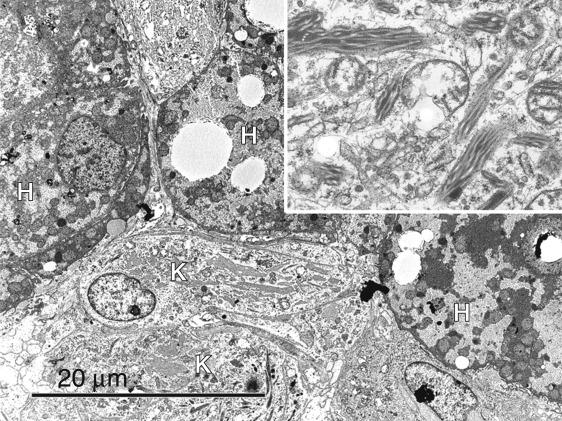
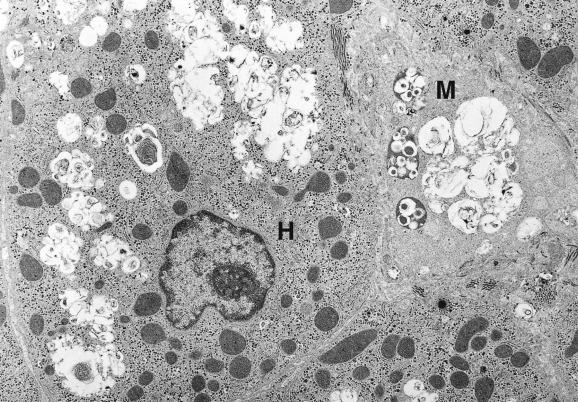
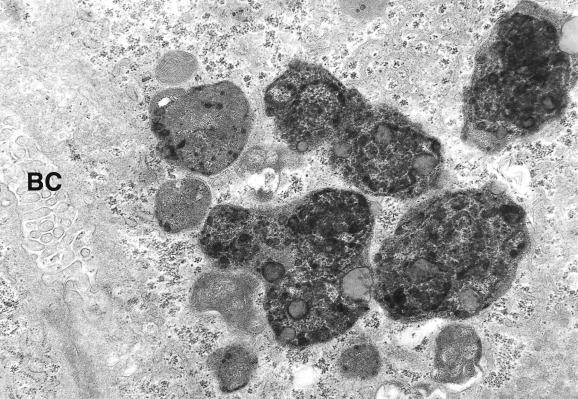
To establish the presence of viral infection. Electron microscopy of liver biopsies may prove to be important when serological test results or cultures for suspected viral infection are unavailable or incomplete. Both intranuclear and intracytoplasmic virions may be identified by the appearances of their spherical or hexagonal capsids, dense core material, surface envelopes, and paracrystalline and lattice-like arrays. These features can be compared with published micrographs for identification of the candidate virion. For example, some adult patients with the unusual finding of giant-cell hepatitis on routine light microscopy have been shown to have paramyxovirus-like particles in the liver as a result of electron microscopic studies of biopsy material. Structural changes to the cell may also develop, as in flavivirus hepatic infection by dengue virus, where invagination of portions of the membranes of endoplasmic reticulum (ER) into their own cisternae create distinctive convoluted packets of membrane material within the ER known as ‘vesicle packets’. Electron microscopy can also be applied to cell cultures, as shown in a study demonstrating 50–90-nm hepatitis C virions. Glutaraldehyde fixation of biopsy specimens is preferred, but viral particles can also be identified in formalin-fixed tissues which are washed and then processed for electron microscopy.
To establish the nature of a tumour of doubtful histogenesis. The ultrastructural features of many tumours, including neuroendocrine tumours and malignant melanomas, help in making a firm diagnosis. The more obvious features such as neurosecretory granules in neuroendocrine tumours survive paraffin embedding; re-embedding of paraffin material for electron microscopy should therefore be considered.
To establish the presence of specific drug-related changes. In liver damage due to a small number of drugs, including perhexiline maleate and amiodarone, hepatocytes contain lysosomes filled with lamellar phospholipid material ( Fig. 17.4 ).
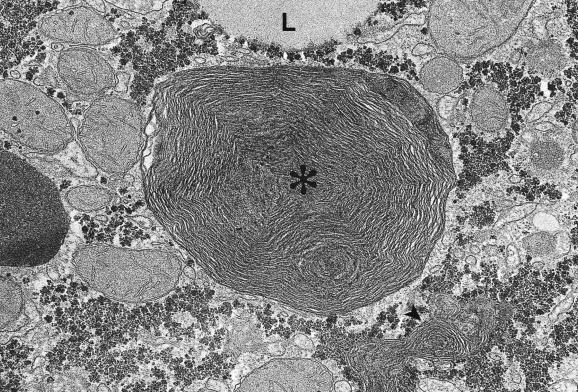
To provide material for research. Electron microscopy offers wide potential for research into human liver disease, and it may be that future research will increase the diagnostic value of electron microscopy in this field. If liver biopsy is performed in a patient who has a disease with potentially helpful or interesting ultrastructural features, small pieces of the specimen can be embedded for electron microscopy and stored indefinitely in block form. The extent to which this is done clearly depends on the resources of the particular laboratory.
Whenever electron microscopy of a liver biopsy specimen is considered, the laboratory should be contacted beforehand and arrangements made for collection and fixation of the specimen at the bedside. Proper processing of the tissue, including optimal fixation, provides the basis for accurate analysis of ultrastructural changes.
The following description of the liver under the TEM is a general one. It should be noted that the quality of fixation will influence the appearance of cells and organelles. The labels in the description of normal liver refer to Figs 17.5 and 17.6 .
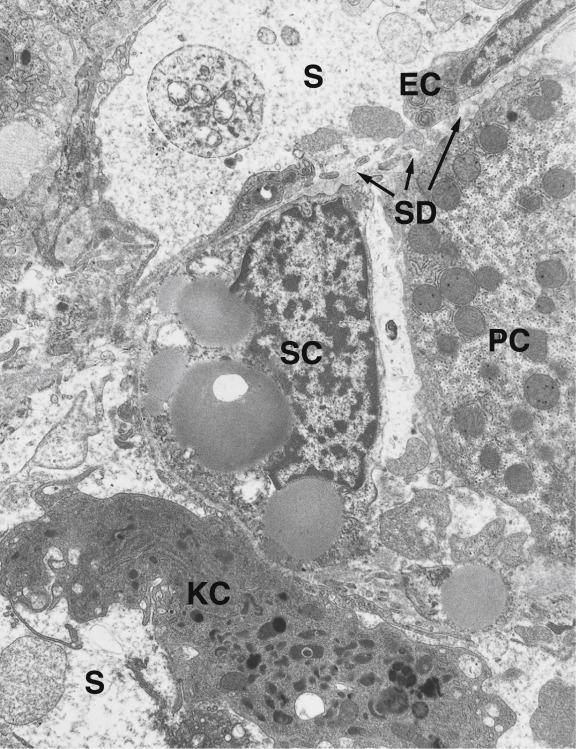
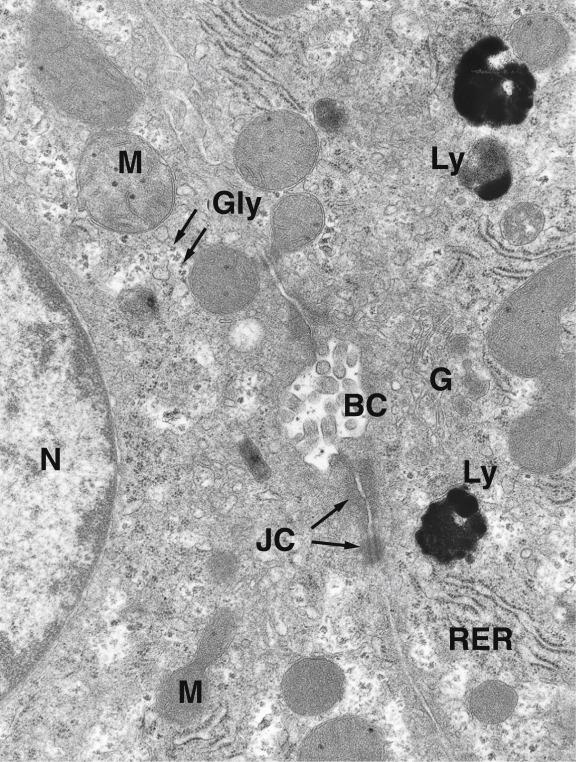
Several cell types are found in the hepatic lobules. The hepatocytes or parenchymal cells are separated from the sinusoidal endothelial cells by the space of Disse, in which there are collagen fibres and stellate cells, formerly known as perisinusoidal cells, Ito cells or fat-storing cells. Within the sinusoidal lumen are Kupffer cells, the hepatic macrophages and large granular lymphocytes (also called pit cells) with natural killer activity.
Hepatocytes have similar features in different lobular regions but vary in detailed structure. For example, there are more lysosomes and mitochondria in periportal than in perivenular hepatocytes, while the converse is true for the smooth-surfaced ER. The hepatocyte is a highly polarised cell with surfaces facing the space of Disse, other hepatocytes and the bile canaliculus. The plasma membrane is specialised in these three areas. Many microvilli project into the space of Disse and into the bile canaliculus. This is a potential space formed by two or three hepatocytes in normal liver, and sometimes more in disease. The intercellular membrane of the hepatocyte is relatively smooth and forms several types of intercellular junctions.
The nucleus is normally limited by a double membrane, the nuclear envelope, which is continuous with the rough-surfaced ER. The nuclear envelope has small pores which are thought to serve as a route of communication between the nucleoplasm and the cytoplasm. Within the nucleus there is irregularly distributed chromatin, and a nucleolus is often visible.
Large amounts of monoparticulate glycogen are seen in some adult hepatocyte nuclei in diabetes mellitus and in insulin resistance, in children and also in type I glycogen storage disease. In type B hepatitis, core virus particles are seen ( Fig. 17.7 ). Intranuclear virions are also seen in infections due to cytomegalovirus, herpesvirus, echovirus and adenovirus.
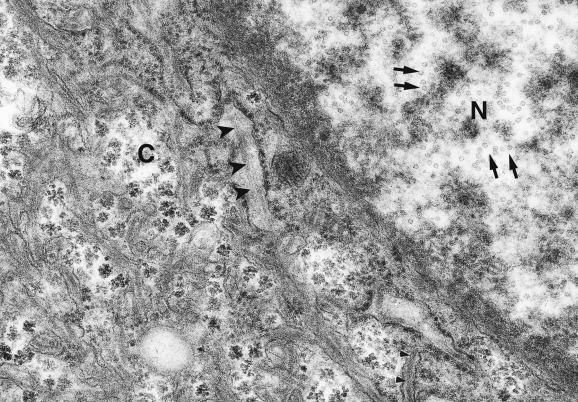
Mitochondria are the sites of oxidative enzyme activity, and are involved in the metabolism of amino acids, lipids and carbohydrates. There are an average of 2200 mitochondria within the hepatocyte. A smooth outer limiting membrane and an inner membrane with deep infoldings, the cristae, give the mitochondria a characteristic appearance. The inner membrane surrounds the mitochondrial matrix which contains many dense granules.
Cristae of atypical shape, crystalline inclusions and enlarged or unusually scanty granules are found in a wide variety of conditions, and sometimes also in normal liver. Giant mitochondria are seen most often in alcoholic liver disease but are also found in non-alcoholic fatty liver disease and other conditions. Immunohistochemistry and immunoelectron microscopy can assist in their detection. They are frequently found in patients with systemic sclerosis. In the early stages of Wilson’s disease mitochondria show variation in shape, increased electron density, widening of the spaces between membranes, vacuolation, enlargement of matrix granules and deposition of crystalline material ( Fig. 17.8 ). Three types of Wilsonian mitochondria are described which show intrafamilial concordance. Abnormal, swollen and irregular mitochondria are found in hepatocytes in Reye’s syndrome and other microvesicular fat syndromes. Highly irregular mitochondria are also seen in mitochondriopathies where there is respiratory chain dysfunction due to defects in mitochondrial DNA (mitochondrial depletion and deletion syndromes; Fig. 17.9 ). Affected neonates and infants may have liver failure and cholestasis in combination with neurological or neuromuscular disease (neurohepatopathy) ( Ch.13, Fig. 13.2 ).
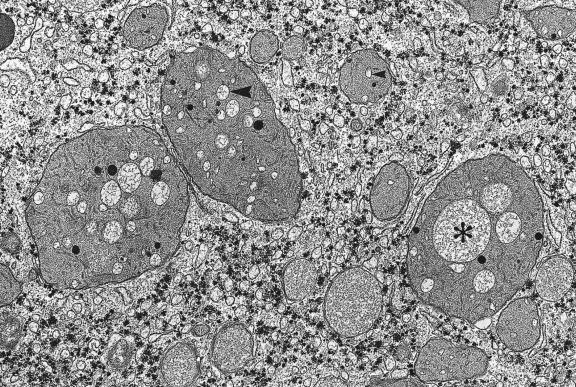
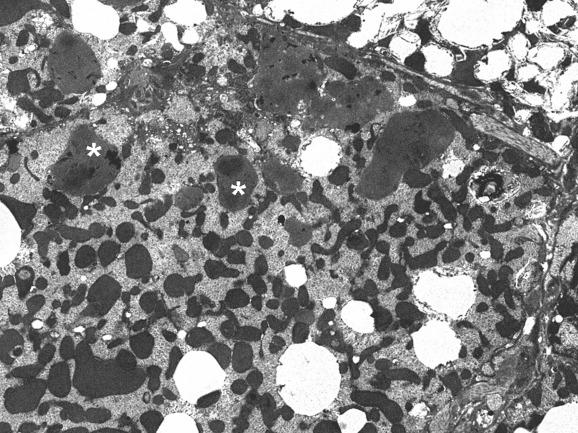
This is an important site of protein synthesis and transport. It also contains enzymes involved in drug and steroid metabolism. Morphologically, the ER is a cisternal membrane-bound system continuous with the nuclear envelope. It is the morphological counterpart of the microsomes. Two main types of ER can be recognised. The rough-surfaced endoplasmic reticulum is studded with ribosomes and is often arranged in a lamellar pattern. The smooth-surfaced endoplasmic reticulum lacks ribosomes and has a tubular or vesicular appearance.
Dilatation, degranulation, vesiculation and proliferation of the ER can be seen in many conditions. Some of these ‘changes’ are also influenced by the fixation procedure, making them difficult to evaluate. Their accurate quantification requires carefully controlled processing conditions and morphometric analysis. However, in α 1 -antitrypsin deficiency, the dilatation of ER is striking, and finely granular material accumulates in the cisternae ( Fig. 17.10 ). In chronic type B hepatitis the cisternae are also dilated and contain tubular structures representing the surface material of the hepatitis B virus ( Fig. 17.6 ), and sometimes complete Dane particles.
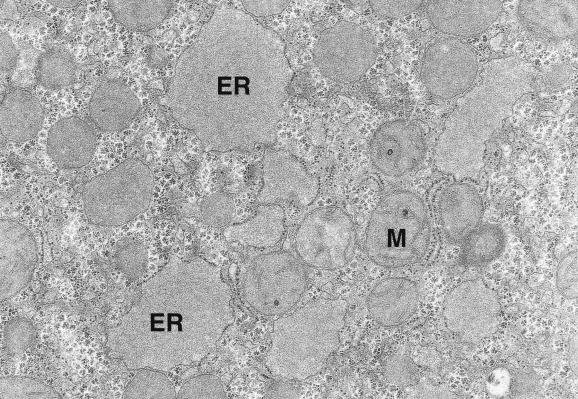
Lysosomes are organelles that carry many different lytic enzymes and are involved in the breakdown of proteins, carbohydrates and lipids. Primary lysosomes are small vesicles containing enzymes but not yet involved in catabolic processes. Secondary lysosomes are membrane-bound, often irregularly shaped electron-dense bodies in which the breakdown processes take place. When undigested residues accumulate and enzyme activity is diminished, the secondary lysosomes are called residual bodies. These are the lipofuscin granules. All types of secondary lysosomes tend to be concentrated around the bile canaliculi.
Become a Clinical Tree membership for Full access and enjoy Unlimited articles
If you are a member. Log in here